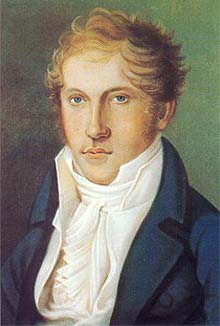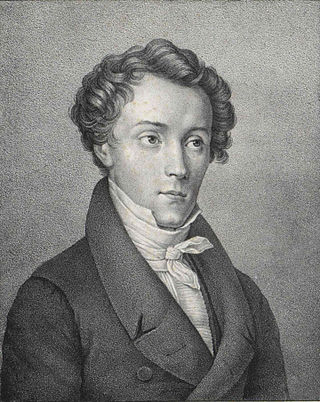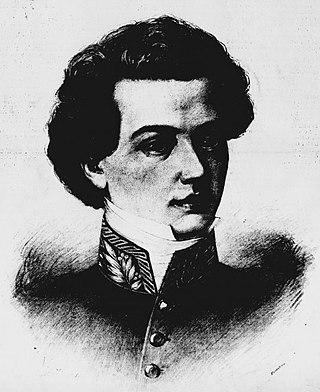Related Research Articles

Ridolfo Luigi Boccherini was an Italian composer and cellist of the Classical era whose music retained a courtly and galante style even while he matured somewhat apart from the major European musical centers. He is best known for a minuet from his String Quintet in E, Op. 11, No. 5, and the Cello Concerto in B flat major. The latter work was long known in the heavily altered version by German cellist and prolific arranger Friedrich Grützmacher, but has recently been restored to its original version.

Louis Spohr, baptized Ludewig Spohr, later often in the modern German form of the name Ludwig, was a German composer, violinist and conductor. Highly regarded during his lifetime, Spohr composed ten symphonies, ten operas, eighteen violin concerti, four clarinet concerti, four oratorios, and various works for small ensemble, chamber music, and art songs. Spohr invented the violin chinrest and the orchestral rehearsal mark. His output spans the transition between Classical and Romantic music, but fell into obscurity following his death, when his music was rarely heard. The late 20th century saw a revival of interest in his oeuvre, especially in Europe.

AntonJoseph Reicha (Rejcha) was a Czech-born, Bavarian-educated, later naturalized French composer and music theorist. A contemporary and lifelong friend of Beethoven, he is now best remembered for his substantial early contributions to the wind quintet literature and his role as teacher of pupils including Franz Liszt, Hector Berlioz and César Franck. He was also an accomplished theorist, and wrote several treatises on various aspects of composition. Some of his theoretical work dealt with experimental methods of composition, which he applied in a variety of works such as fugues and études for piano and string quartet.

Karol Józef Lipiński was a Polish music composer and virtuoso violinist active during the partitions of Poland. The Karol Lipiński University of Music in Wrocław, Poland is named after him.

Andreas Jakob Romberg was a German violinist and composer.

Friedrich Ernst Fesca was a German violinist and composer of instrumental music.
Potpourri or Pot-Pourri is a kind of musical form structured as ABCDEF..., the same as medley or, sometimes, fantasia. It is often used in light, easy-going and popular types of music.

The String Octet in E-flat major, Op. 20, was written by the 16-year-old Felix Mendelssohn during the fall of 1825 and completed on October 15. Written for four violins, two violas, and two cellos, this work created a new chamber music genre. Conrad Wilson summarizes much of its reception ever since: "Its youthful verve, brilliance and perfection make it one of the miracles of nineteenth-century music." This was one of the first works of Mendelssohn to be very well-received.
Classic Produktion Osnabrück is a record label founded in 1986 by Georg Ortmann and several others. Its declared mission is to fill niches in the recorded classical repertory, with an emphasis on romantic, late romantic, and 20th-century music. The label also aims to release complete cycles of recordings, such as complete sets of symphonies, concertos, chamber music, and so forth. It is the house label of online retailer jpc.
The String Quartet No. 2 in A minor, Op. 13, was composed by Felix Mendelssohn in 1827. Written when he was 18 years old, it was, despite its official number, Mendelssohn's first mature string quartet. One of Mendelssohn's most passionate works, the A minor Quartet is one of the earliest and most significant examples of cyclic form in music.
Louis Spohr's String Quartet No. 30 in A major, Op. 93, was completed in September of 1835, it is one of eight such works Spohr wrote between 1806 and 1835. He would not write another string quartet for ten years.
Louis Spohr's String Quartet No. 11 in E major, Op. 43, was completed in May of 1818. It is one of eight similar works Spohr wrote between 1806 and 1835. Like a concerto, the work is designed to display a soloists skills, but in a more intimate setting than the concert hall.
Louis Spohr's String Quartet No. 3 in D minor, Op. 11, was completed in 1806, then published in 1808. It is the first of eight quatuors brillants written by Spohr. Inspired by similar works written by Viotti and Rode, the composition is a mini-concerto, written to provide the composer with the means of demonstrating his skills with a violin in a more intimate setting than a concert hall.
Louis Spohr's String Quartet No. 19 in A major, Op. 68, was composed by Spohr in 1823. Like a concerto, the work is designed to display a soloist's skills, but in a more intimate setting than the concert hall.
Louis Spohr's String Quartet No. 6 in G minor, Op. 27, was completed in 1812. Dedicated to Count Razumovsky, the dedicatee of Beethoven, Opus 59. string quartets, the composition, like the earlier String Quartet No. 3, is a concertante work with the musical emphasis being placed on the first violinist, while the other players act as accompaniment. Keith Warsop notes that the second Adagio movement seems to have been adapted from sketches to an unfinished violin concerto.
The Clarinet Concerto No. 1 in C minor, Op. 26, was composed by Louis Spohr between fall of 1808 and early 1809, and published in 1812. The concerto was the first of four that Spohr would compose in his lifetime, all of which were dedicated to the German clarinet virtuoso Johann Simon Hermstedt.
From March 1816 to August 1817, Franz Schubert composed four violin sonatas. All four were published after the composer's death: the first three, D 384, 385 and 408, as Sonatinas in 1836, and the last one, D 574, as Duo in 1851. Schubert composed two more pieces for violin and piano, in October 1826 and December 1827 respectively: a Rondo, D 895, which was published during the composer's lifetime (Op. 70), and a Fantasy, D 934, which was premiered in January 1828, less than a year before the composer's death.
In 1816, Franz Schubert composed his first three violin sonatas, D 384, 385 and 408. They were published after the composer's death as Sonatinas in 1836. These sonatas breathe an intimate atmosphere, requiring relatively little virtuoso bravura from their performers.

Josef Slavík, also known as Josef Slawjk or Joseph Slawik, was a Bohemian violin virtuoso and composer, who was expected by Vienna musical critics to become Paganini's successor after composing a supposedly unplayable Concerto in F-sharp minor and teaching himself to play Paganini's "La Campanella" after a single hearing.
References
- Notes
- 1 2 Brown & Warsop. Liner Notes to Marco Polo 8.225982
- ↑ See IMSLP.
- Sources
- Clive Brown & Keith Warsop. Liner Notes to String Quartets (Complete), Vol. 14 – Nos. 31 and 36.
- Potpourri No. 4 (Spohr) : Scores at the International Music Score Library Project